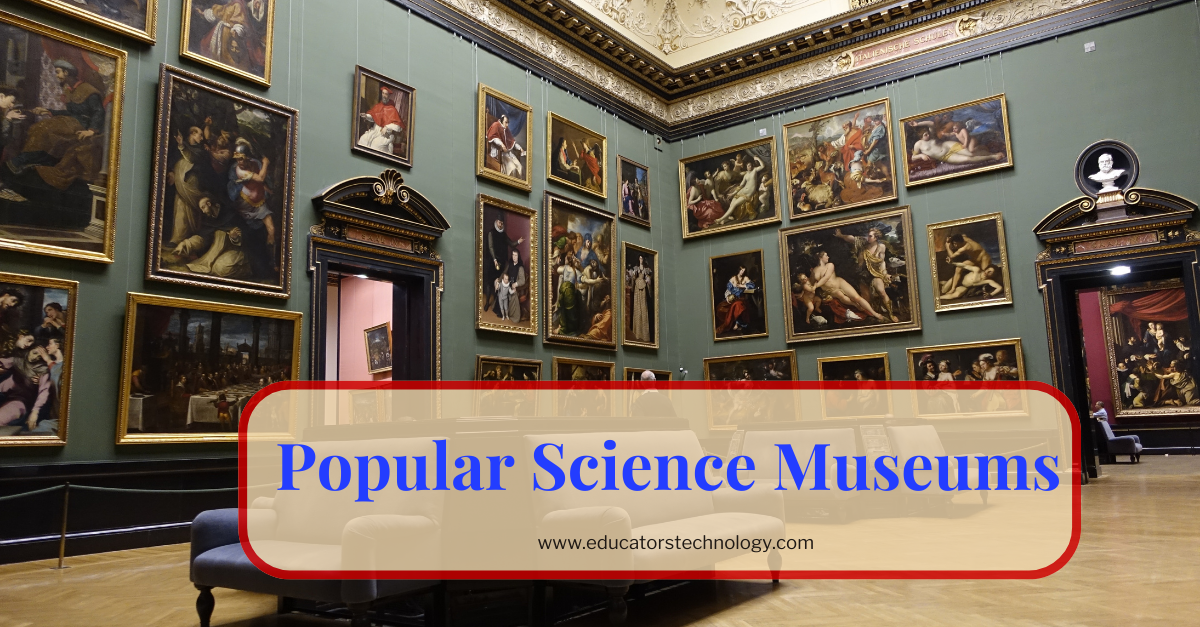We human beings have come a long way towards understanding the world (or probably the worlds) we are living in. Our knowledge of the inner workings of this world is expanding exponentially and in both directions: horizontally and vertically. From the invention of fire to Mars exploration, our insatiable appetite to discover and learn is getting wilder and wilder and with it our scientific knowledge.
Science museums from all around the world capture and document this knowledge allowing anyone interested in learning about science, to access this wealth of knowledge and learn about major achievements and milestones that got us where we are today.
In today’s post I share with you this collection of 7 popular science museums as featured in Google Arts & Culture. You can use resources in your teaching to help students learn more about science (and ultimately develop a love for it) and see how it has radically transformed our life. For some of these museums, Google Arts & Culture provides virtual tours which are especially helpful to take students on virtual field trips and explore these museums from a vistor’s perspective.
1. Smithsonian Air and Space Museum
The Smithsonian Air and Space Museum is one of the largest science museums in the world. It hosts a wide variety of air and space artifacts documenting the history of human flight from its early inception to its current state. Google Art & Culture provides you with an immersive 360 degree tour of the museum allowing you to see its artifacts and experience the Space Shuttle from an astronaut’s-eye view.
To learn more about the museum, you may want to check its website. It contains tons of educational resources and materials that you can use with students in class. There is a section for stories covering major space and aviation events such as ‘Apollo 11: the Moon Landing’ story, the story of ‘Wright Brothers’ , the story of ‘Bessie Coleman’, and more.
2. Cité de l’espace, Toulouse
The City of Space, is a science museum focused entirely on everything related to space exploration. The museum is located in the peripheries of Toulouse city in France. The City of Space hosts interactive exhibits, two planetariums, and an IMAX movie theater. “Outside are full-size replicas of the European Ariane rocket, the Soviet space station Mir, and Hubble Telescope.” Visit the website of City of Space.
3. Museum of Natural Sciences, Brussels
The Museum of Natural Sciences in Brussels hosts the largest dinosaur exhibit in the world. The museum is especially famous for its 30 fossilized Iguanodon skeletons that were first discovered in 1878. The Museum of Natural Sciences contains several galleries and sections. For instance, the Gallery of Humankind helps you learn about the human body and how it has evolved over the years.
The Gallery of Evolution documents our journey in history and showcases artifacts chronicling our evolutionary journey. “You can also find out about urban species in BiodiverCITY, discover specimens which illustrate the Museum’s history in the 250 years of Natural Sciences hall, admire the magnificent crystals in the Mineral Hall, and experience something new every year by visiting our temporary exhibitions or by taking part in one of our Education Service’s interactive activities.” Visit the museum’s website.
4. The Science Museum, London
The Science Museum in London is home to the world collection of scientific breakthroughs, medical achievements, and technological innovations. The museum also features interactive exhibitions, IMAX documentaries, and a huge online library of digital resources that contains over 3250.000 objects. These resources are arranged into various collections including art and science, astronomy, computing, mathematics, robots, space, communication, and more.
“Among its many weird and wonderful exhibits is a trip deep into the uncanny valley with a robotics room, charting the history of humanoid androids from Harry the Trumpet-Player robot to the Japanese “Kodomoroid” robot news anchor. ” Visit the museum’s website.
5. Nagoya City Science Museum, Nagoya
Nagoya City Science Museum is located in Nagoya, one of the largest cities in Japan. The main highlight of the museum is its wonderful planetarium which is the largest in the world. Google Arts & Culture allows you to virtually explore the planetarium and see its engineering wonder first-hand. There are three main sections in Nagoya City Science Museum: modern technology, general science, and life sciences. Since 2012, the museum witnessed some major renovations to accommodate the planetarium.
6. Academy of Natural Sciences of Drexel University
Founded in 1812, the Academy of Natural Sciences of Drexel University is a world-class museum dedicated to natural history. “The popularity of its exhibits soared in 1868 with the debut of the world’s first mounted dinosaur skeleton, Hadrosaurus. Today, the museum even offers sleepovers for promising young palaeontologists.”
The museum’s website provides a wide variety of educational materials to enhance science curriculum. These include activities, videos, and lessons on various topics related to biodiversity, climate change, evolution, water, and more.
7. Gwacheon National Science Museum, Gwacheon
Interested in learning about the achievements of South Korean scientists? The Gwacheon National Science Museum has you covered. The museum, which is located in Gwacheon city in South Korea , is considered one of the most ‘well-equipped’ science museums in the world. “Divided between medicines, physics, chemistry, and ‘world saving’ inventions, the museum seeks to inspire the next generation of inventors and technicians.”






